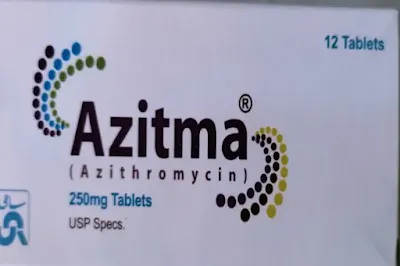Azitima (Azithromycin) tablets and suspension
Azitma tablets 250mg, 500mg
Azitma suspension 200mg/5ml
PHARMACOLOGY:
Mechanism of Action Azithromycin exerts its antibacterial action by binding to the 50S ribosomal sub unit of susceptible organisms and thus interfering with microbial protein synthesis and inhibition of peptide translocation. macromolecule synthesis isn't affected.
Azitma (Azithromycin) INDICATIONS:
Azitma (Azithromycin) is indicated for the treatment of patients with mild to moderate infections caused by susceptible strains of the designated micro-organisms within the precise conditions listed below:
Azitma (Azithromycin) DOSAGE AND ADMINISTRATION:
Adults In uncomplicated Chiamydia trachomatis urethritis and cervicitis, the dosage is 1000mg in one single oral dose.
For all other indications the dose is 1500mg, to be administered as 500mg per day for 3 consecutive days. As an alternate the identical total dose (1500mg) can also be administered over a period of 5 days with 500mg on the first day and 250mg on the second to the fifth day
Infection Recommended Dose / Duration of Therapy
1. Infection: Community-acquired pneumonia (mild severity) Pharyngitis/Tonsilitis (Second-line therapy Skin/skin structure infections (uncomplicated):
Dose: 500mg mutually dose on day 1, followad by 250mg once daily on day 2 through 5
2. Infection: Acute bacterial exacerbations of bronchitis (mild to moderate)
Dose: 500mg collectively dose on day 1, followed by 250mg once dally on day 2 through 5 or 500mg once daily for 3 days
3. Infection: Acute bacterial sinusitis
Dose: 500mg once daily for 3 days
4. Infection: Genital ulcer disease (Chancroid ) Non-gonococcal urethritis and cervicitis.
Dose: One single 1g dose
5. Infection: Gonococcal urethritis and cervicitis.
Dose: One single 2g dose
Children
The total dosage in children aged 1 year and older is 30mg/kg administered as 1Omg/kg once daily for 3 days, or over a period of 5 days starling with one dose of 10mg/kg on the first day, followed by doses of 5mg/kg per day for the following 4 days.
ADVERSE REACTIONS:
• Cardiovascular
• Palpitations and pain Gastrointestinal:
• Dyspepsia,
• flatulenoe,
• vomiting,
• melena and cholestatic jaundice.
General:
• Fatigue
Allergic:
• Rash,
• pruritus,
• photosensitivity and angioedema
CONTRAINDICATIONS:
Azithromycin is contraindicated in patients with known hypersensitivity to azithromycin or any macrolide antibioticsPRECAUTIONS:
As with erythromycin and other macrolides, rare serious aversions, including angioedema and anaphylaxis (rarely fatal), are reported.
variety of those reactions with Azithromycin have resulted in recurrent symptoms and required a extended period of observation and treatment Since liver is that the principal route of elimination for azithromycin.
Cases of fulminant hepatitis potentialty leading to life-threatening liver failure are reported with azithromycin.
Some patients may have had pre-existing hepatic disease or may are taking other hepatotoxic medicinal products just just in case of signs and symptoms of liver dysfunction.
Special Populations:
PREGNANCY
There aren't Any Adequate And welcontrole Studies in Pregnant Women. Azithromycin should not be used during pregnancy unless the benefits outweigh the potential risks.
Nursing Mothers
Azithromycin has been reported to be excreted in human breast milk in bit. Caution should be exercised when azithromycin is run to a nursing woman.
DRUG INTERACTIONS:
Antacids:
In patients receiving both azithromycin and antacids, the drugs mustn't be taken simultaneously. Azithrornycin should be taken a minimum of 1 hour before or 2 hours after the antacid.Cyciosporine:
Caution should be exercised before considering concurrent administration of these drugs.If co-administration of these drugs is critical, cyclosporine levels should be monitored and also the dose should be adjusted accordingly.Theophylline:
Theophylline levels could even be increased in patients taking azithromycin Coumarin-type oral anticoagulants: Consideration should lean to the frequency of monitoring prothrombin time , when azithromycin is used in patients receiving Coumarin-type oral anti-coagulants.
Digoxin:
In patients receiving concomitant azithromycin, a related azalide antibiotic, and digoxin, the likelihood of raised digoxin levels should be borne in mind.
Azithromycin OVERDOSE:
Adverse events experienced in additional than recommended doses were almost like those seen at normal doses. the quality symptoms of an overdose with macrolide antibiotics include severe nausea, vomiting and diarrhea, within the event of over dosage, general symptomatic and supportive measures are indicated as required.


Post a Comment